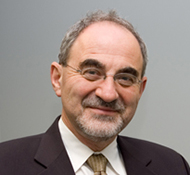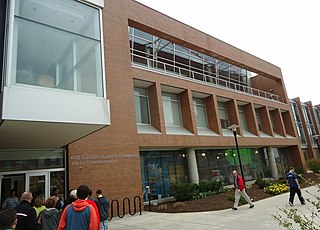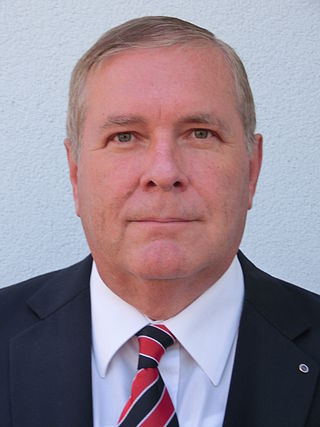Related Research Articles
A thin-film transistor (TFT) is a special type of field-effect transistor (FET) where the transistor is made by thin film deposition. TFTs are grown on a supporting substrate, such as glass. This differs from the conventional bulk metal oxide field effect transistor (MOSFET), where the semiconductor material typically is the substrate, such as a silicon wafer. The traditional application of TFTs is in TFT liquid-crystal displays.

Eli Yablonovitch is an American physicist and engineer who, along with Sajeev John, founded the field of photonic crystals in 1987. He and his team were the first to create a 3-dimensional structure that exhibited a full photonic bandgap, which has been named Yablonovite. In addition to pioneering photonic crystals, he was the first to recognize that a strained quantum-well laser has a significantly reduced threshold current compared to its unstrained counterpart. This is now employed in the majority of semiconductor lasers fabricated throughout the world. His seminal paper reporting inhibited spontaneous emission in photonic crystals is among the most highly cited papers in physics and engineering.

Alec Nigel Broers, Baron Broers, is a British electrical engineer.

The Kate Gleason College of Engineering (KGCOE) is the engineering college at the Rochester Institute of Technology. The college is home to all of RIT's engineering programs except for software engineering, which is part of the B. Thomas Golisano College of Computing and Information Sciences. Entering the 2023-24 academic year, the student body consisted of 2,947 students, with 400 graduate students. About 23% of the students were female.
Ghavam G. Shahidi is an Iranian-American electrical engineer and IBM Fellow. He is the director of Silicon Technology at the IBM Thomas J Watson Research Center. He is best known for his pioneering work in silicon-on-insulator (SOI) complementary metal–oxide–semiconductor (CMOS) technology since the late 1980s.

Esther Marley Conwell was a pioneering American chemist and physicist, best known for the Conwell-Weisskopf theory that describes how electrons travel through semiconductors, a breakthrough that helped revolutionize modern computing. During her life, she was described as one of the most important women in science.
The IEEE Robert N. Noyce Medal is a science award presented by the IEEE for outstanding contributions to the microelectronics industry. It is given to individuals who have demonstrated contributions in multiple areas including technology development, business development, industry leadership, development of technology policy, and standards development. The medal is named in honour of Robert N. Noyce, the co-founder of Intel Corporation. He was also renowned for his 1959 invention of the integrated circuit. The medal is funded by Intel Corporation and was first awarded in 2000.
The IEEE Undergraduate Teaching Award is a Technical Field Award of the IEEE that was established by the IEEE Board of Directors in 1990. It is presented for inspirational teaching of undergraduate students in the fields of interest of the IEEE.
Chenming Calvin Hu is a Taiwanese-American electronic engineer who specializes in microelectronics. He is TSMC Distinguished Professor Emeritus in the electronic engineering and computer science department of the University of California, Berkeley, in the United States. In 2009, the Institute of Electrical and Electronics Engineers described him as a “microelectronics visionary … whose seminal work on metal-oxide semiconductor MOS reliability and device modeling has had enormous impact on the continued scaling of electronic devices”.

Ching Wan Tang is a Hong Kong–American physical chemist. He was inducted into the National Inventors Hall of Fame in 2018 for inventing OLED, and was awarded the 2011 Wolf Prize in Chemistry. Tang is the IAS Bank of East Asia Professor at the Hong Kong University of Science and Technology and previously served as the Doris Johns Cherry Professor at the University of Rochester.

Siegfried Selberherr is an Austrian scientist in the field of microelectronics. He is a professor at the Institute for Microelectronics of the Technische Universität Wien . His primary research interest is in modeling and simulation of physical phenomena in the field of microelectronics.

Jerry M. Woodall is a professor of electrical and computer engineering at the University of California, Davis who is widely known for his revolutionary work on LEDs and semiconductors. Over the course of his career, he has published close to 400 scientific articles and his work has directly contributed to the development of major technologies that are used around the world, such as TVs, optical fibers, and mobile phones. Woodall currently holds over 80 U.S. patents for a variety of inventions and has received prestigious awards from IBM, NASA, and the U.S. President for his contributions to science, technology, and humanity.

Sorab (Soli) K. Ghandhi was a professor Emeritus at Rensselaer Polytechnic Institute (RPI) known for his pioneering work in electrical engineering and microelectronics education, and in the research and development of Organometallic Vapor Phase Epitaxy (OMVPE) for compound semiconductors. He was the recipient of the IEEE Education Award "For pioneering contributions to semiconductor and microelectronics education" in 2010.

John Robertson FRS is a Professor of Electronics, in the Department of Engineering at the University of Cambridge. He is a leading specialist in the theory of amorphous carbon and related materials.
Low-temperature polycrystalline silicon (LTPS) is polycrystalline silicon that has been synthesized at relatively low temperatures compared to in traditional methods. LTPS is important for display industries, since the use of large glass panels prohibits exposure to deformative high temperatures. More specifically, the use of polycrystalline silicon in thin-film transistors (LTPS-TFT) has high potential for large-scale production of electronic devices like flat panel LCD displays or image sensors.
Dr. Márta Rencz is an Electrical Engineer. She is a faculty member and former Head of Department at the Budapest University of Technology and Economics and a member of the Hungarian Academy of Sciences.
Francesca Iacopi is an engineer, researcher and an academic. She specializes in materials and nanoelectronics engineering and is a professor at the University of Technology Sydney. She is a chief investigator of the ARC Centre of Excellence in Transformative Meta-Optical Systems, a Fellow of the Institution of Engineers Australia, and a senior member of Institute of Electrical and Electronics Engineers.

Aristos Christou is an American engineer and scientist, academic professor and researcher. He is a Professor of Materials Science, Professor of Mechanical Engineering and Professor of Reliability Engineering at the University of Maryland.
April S. Brown is an American electrical engineer and materials scientist in the Duke University Pratt School of Engineering, where she is a professor of electrical and computer engineering and the former John Cocke Professor of Electrical and Computer Engineering.
Srimanta Baishya is an Indian academician and Professor at the National Institute of Technology Silchar in the Department of Electronics and Communications Engineering. He earned his B.E. in electrical engineering from Assam Engineering College in Guwahati, followed by an M.Tech. in electrical engineering from the Indian Institute of Technology Kanpur. Baishya further pursued his Ph.D. in MOS Modeling from Jadavpur University in Kolkata. Presently, he serves as a professor at NIT Silchar, focusing on research areas such as MOS physics, modeling, and MEMS.
References
- 1 2 "Santosh Kurinec profile". rit.edu. Retrieved 2018-11-03.
- 1 2 "Interview with Prof. Santosh Kurinec". EEWeb. July 29, 2014.
- 1 2 3 "Santosh K. Kurinec". semiconwest.org. Archived from the original on 2016-07-18.
- 1 2 Michelle Cometa (June 14, 2018). "Engineering professor inducted into international Women in Technology Hall of Fame". rit.edu.
- ↑ Gordon, Dane R. (2007). Rochester Institute of Technology: Industrial Development and Educational Innovation in an American City, 1829-2006. RIT Cary Graphic Arts Press. ISBN 9781933360232. OL 12337941M.
- ↑ Jessica Spies (Nov 14, 2011). "Spotlight on ... RIT professor Santosh Kurinec". Monroe County Post.
- ↑ Kurinec, Santosh K.; Rack, Philip D.; Potter, Michael D.; Blanton, Thomas N. (June 2000). "Unit Cell Indexing of Luminescent Tantalum Zinc Oxide". Journal of Materials Research. 15 (6): 1320–1323. Bibcode:2000JMatR..15.1320K. doi:10.1557/JMR.2000.0191. ISSN 2044-5326. S2CID 95915893.
- ↑ "Unit cell indexing of luminescent tantalum zinc oxide : Tables of Contents". serials.unibo.it. Retrieved 2018-11-04.
- 1 2 3 "Santosh Kurinec, PhD". witi.com.
- 1 2 "Meet the 2018 Women in Technology Hall of Fame Inductees". PR Newswire (Press release).
- ↑ "J-PV-steering committee". Archived from the original on 2014-10-13.
- ↑ "Member Profile : Santosh Kurinec". services27.ieee.org.
- ↑ "EDS Members Named Recipients of IEEE Technical Field Awards". Archived from the original on 2014-02-21.
- ↑ Michelle Cometa (April 25, 2013). "Santosh Kurinec and Maureen Valentine named 'Engineers of Distinction'". rit.edu. Retrieved 2018-11-03.